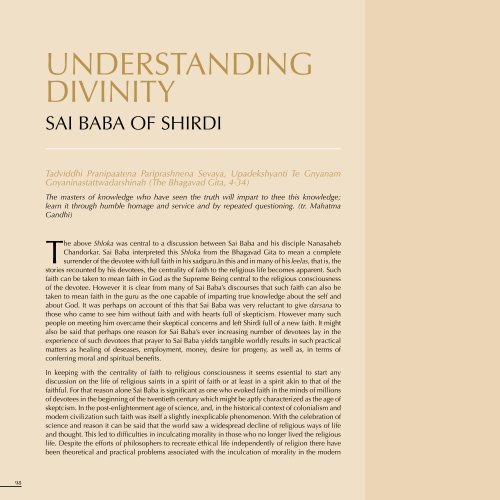download - Art Positive
download - Art Positive
download - Art Positive
Create successful ePaper yourself
Turn your PDF publications into a flip-book with our unique Google optimized e-Paper software.
Understanding<br />
Divinity<br />
Sai Baba of Shirdi<br />
Tadviddhi Pranipaatena Pariprashnena Sevaya, Upadekshyanti Te Gnyanam<br />
Gnyaninastattwadarshinah (The Bhagavad Gita, 4-34)<br />
The masters of knowledge who have seen the truth will impart to thee this knowledge;<br />
learn it through humble homage and service and by repeated questioning. (tr. Mahatma<br />
Gandhi)<br />
The above Shloka was central to a discussion between Sai Baba and his disciple Nanasaheb<br />
Chandorkar. Sai Baba interpreted this Shloka from the Bhagavad Gita to mean a complete<br />
surrender of the devotee with full faith in his sadguru.In this and in many of his leelas, that is, the<br />
stories recounted by his devotees, the centrality of faith to the religious life becomes apparent. Such<br />
faith can be taken to mean faith in God as the Supreme Being central to the religious consciousness<br />
of the devotee. However it is clear from many of Sai Baba’s discourses that such faith can also be<br />
taken to mean faith in the guru as the one capable of imparting true knowledge about the self and<br />
about God. It was perhaps on account of this that Sai Baba was very reluctant to give darsana to<br />
those who came to see him without faith and with hearts full of skepticism. However many such<br />
people on meeting him overcame their skeptical concerns and left Shirdi full of a new faith. It might<br />
also be said that perhaps one reason for Sai Baba’s ever increasing number of devotees lay in the<br />
experience of such devotees that prayer to Sai Baba yields tangible worldly results in such practical<br />
matters as healing of deseases, employment, money, desire for progeny, as well as, in terms of<br />
conferring moral and spiritual benefits.<br />
In keeping with the centrality of faith to religious consciousness it seems essential to start any<br />
discussion on the life of religious saints in a spirit of faith or at least in a spirit akin to that of the<br />
faithful. For that reason alone Sai Baba is significant as one who evoked faith in the minds of millions<br />
of devotees in the beginning of the twentieth century which might be aptly characterized as the age of<br />
skeptcism. In the post-enlightenment age of science, and, in the historical context of colonialism and<br />
modern civilization such faith was itself a slightly inexplicable phenomenon. With the celebration of<br />
science and reason it can be said that the world saw a widespread decline of religious ways of life<br />
and thought. This led to difficulties in inculcating morality in those who no longer lived the religious<br />
life. Despite the efforts of philosophers to recreate ethical life independently of religion there have<br />
been theoretical and practical problems associated with the inculcation of morality in the modern<br />
98




